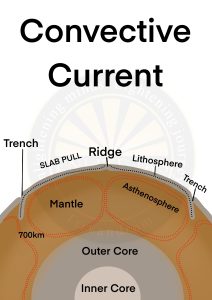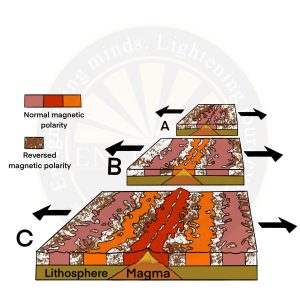Idea
- The hypothesis of seafloor spreading was put forward by H. Harry Hess in 1960.
Basis Theory for Seafloor Spreading Theory
- Convection Current Theory
- Put forward by Arthur Holmes in the 1930s.
- The theory discussed the possibility of convection currents in the mantle and these currents are generated due to radioactive elements causing thermal differences in the mantle.
- As per the theory, the intense heat generated by radioactive substances in the mantle seeks a path to escape and gives rise to the formation of convection currents in the mantle.
- Relation with divergence and convergence of plates
- Wherever rising limbs of these currents meet, oceanic ridges are formed on the seafloor due to the divergence of the lithospheric plates (tectonic plates).
- Wherever the failing limbs meet, trenches are formed due to the convergence of the lithospheric plates (tectonic plates).
- The movement of the lithospheric plates is caused by the movement of the magma in the mantle.

- Paleomagnetism
- Paleomagnetism is the study of the record of the earth’s magnetic field with the help of magnetic fields recorded in rocks, sediment, or archaeological materials.
- The polarity of the Earth’s magnetic field and magnetic field reversals are thus detectable by studying the rocks of different ages.
- Rocks formed from underwater volcanic activity are mainly basaltic (low silica, iron-rich) which makes up most of the ocean floor.
- Basalt contains magnetic minerals, and as the rock is solidifying, these minerals align themselves in the direction of the magnetic field.
- This locks in a record of which way the magnetic field was positioned at the time.
- Paleomagnetic studies of rocks have demonstrated that the orientation of the earth’s magnetic field has frequently alternated (geomagnetic reversal) over geologic time.
- What is the evidence for Seafloor Spreading and Plate Tectonics?
- Paleomagnetism led to the revival of the continental drift hypothesis and its transformation into theories of Sea Floor Spreading and Plate Tectonics.
- The regions that hold the unique record of earth’s magnetic field lie along the mid-ocean ridges where the seafloor is spreading.
- On studying the paleomagnetic rocks on either side of the oceanic ridges, it was found that alternate magnetic rock stripes were flipped so that one stripe would be of normal polarity and the next, reversed.
- Hence, paleomagnetic rocks (paleo: denoting rocks) on either side of the mid-ocean or submarine ridges provide the most important evidence to the concept of Sea Floor Spreading.
- Magnetic field records also provide information on the past location of tectonic plates.
- These oceanic ridges are boundaries where tectonic plates are diverging (moving apart).
- The fissure or vent (in between the ridge) between the plates allowed the magma to rise and harden into a long narrow band of rock on either side of the vent.
- Rising magma assumes the polarity of Earth’s geomagnetic field at the time before it solidifies on the oceanic crust.
- As the conventional currents pull the oceanic plates apart, the solidified band of rock moves away from the vent (or ridge), and a new band of rock takes its place a few million years later when the magnetic field is reversed. This results in this magnetic striping where the adjacent rock bands have opposite polarities.
- This process repeats over and over giving rise to a series of narrow parallel rock bands on either side of the ridge and alternating pattern of magnetic striping on the seafloor.

